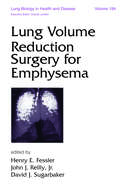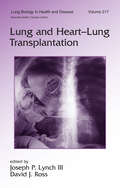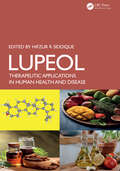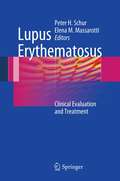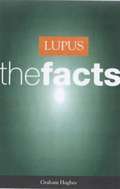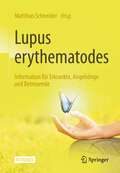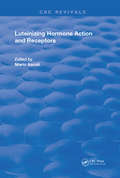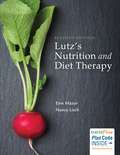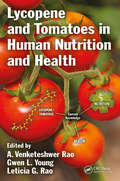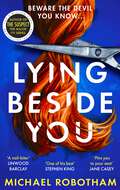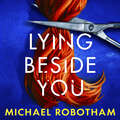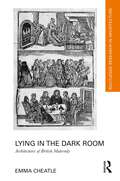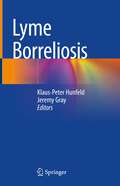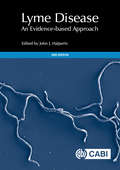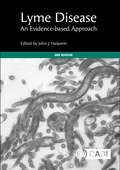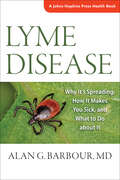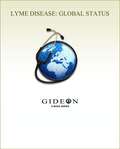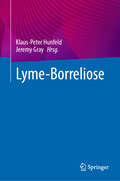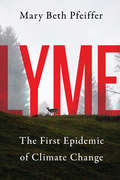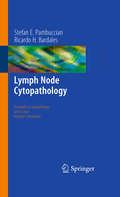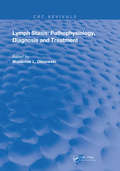- Table View
- List View
Lung Volume Reduction Surgery for Emphysema (Lung Biology in Health and Disease)
by Henry E. FesslerConsidering the epidemiology of COPD, this title collects all available knowledge on the subject, featuring data on the national emphysema treatment trial. It explores the epidemiology of emphysema, the management of complications and surgical controversies in lung volume reduction surgery for emphysema (LVRS).
Lung and Heart-Lung Transplantation (Lung Biology in Health and Disease)
by David J. Ross Joseph P. Lynch IIIA comprehensive review of clinical and exploratory aspects of lung (LT) and heart-lung transplantation (HLT), this reference focuses on cumulative data from the International Registry with data on outcomes associated with LT and HLT worldwide. Collecting in-depth discussions on graft dysfunction, infectious complications, and indications of LT for
Lupeol: Therapeutic Applications in Human Health and Disease
by Hifzur R SiddiqueThis book explores the therapeutic potential of Lupeol, a naturally occurring triterpenoid. The introductory chapters present its physicochemical properties, chemical modifications, and synthetic analogs, highlighting its potential against various diseases. The beneficial effects of Lupeol are explored across a broad range of health conditions, including its role in skin diseases and cardioprotective effects. The book highlights its antioxidant, anti-inflammatory, and chemopreventive effects, including its use in nanoparticle formulations for enhanced efficacy. Its protective properties for the kidneys, liver, and brain are also explored, along with its ability to sensitize resistant cells to chemotherapy and radiation. The chapters discuss the antimicrobial, antiparasitic, and anti-cancer effects of Lupeol, its role in inhibiting tumor growth, angiogenesis, and metastasis, and its modulation of transcription factors involved in disease pathways. Traditional uses of Lupeol-containing plants in systems like Unani medicine and its influence on gut microbiota and postbiotics for disease management are examined. Towards the end, the book also addresses Lupeol's safety, toxicology, and future clinical potential.Key Features: Examines the therapeutic potential of Lupeol, a naturally occurring triterpenoid, through its diverse health applications Presents the physicochemical properties, chemical modifications, and synthetic analogs of Lupeol Highlights the antioxidant, anti-inflammatory, and chemopreventive effects of Lupeol and its role in nanoparticle formulations for enhanced efficacy in cancer treatments. Explores the cardioprotective, nephroprotective, hepatoprotective, and neuroprotective properties of Lupeol Addresses the safety, toxicology, and future clinical applications of Lupeol It is a useful resource for researchers and students in pharmaceutical sciences, ethnopharmacology, and traditional medicine.
Lupus Erythematosus
by Elena M. Massarotti Peter H. SchurOften considered the prototypic autoimmune disease, Lupus is characterized by protean manifestations and affects a wide range of organ systems. Despite widespread availability of anti nuclear antibody testing and other technological diagnostic advances, the diagnosis of lupus can be elusive, difficult, and inexact. Treatment of the disease can also be challenging. Advances in immunology and biotechnology have led to a burgeoning world of new therapies in development that offer patients the real possibility of new therapies and physicians and scientists novel insights into the pathogenesis of this complicated immunological disease. Lupus Erythematosus: Clinical Evaluation and Treatment summarizes the clinical aspects of lupus facing the general clinician in the 21st century. In this invaluable, practical book, the reader will find introductory chapters regarding general diagnostic and treatment principles, followed by chapters addressing the lupus-specific organ manifestations. Special topics regarding pregnancy and comorbidities are also presented. Written by highly experienced physicians with special expertise in lupus, Lupus Erythematosus: Clinical Evaluation and Treatment is an indispensable reference for the common and not so common problems affecting patients with lupus.
Lupus The Facts
by Graham HughesThis easy-to-read book explains Lupus. How does Lupus affect people? What can be done if someone develops lupus?
Lupus erythematodes: Information für Erkrankte, Angehörige und Betreuende
by Matthias SchneiderLupus erythematodes ist eine Erkrankung des Immunsystems mit sehr unterschiedlichem Erscheinungsbild, die Zahl nicht diagnostizierter Fälle ist hoch. Das Buch trägt seinen Teil zur umfassenden Aufklärung über diese Erkrankung bei. Das Ziel dieses Ratgebers ist es, Menschen mit der Diagnose „Lupus erythematodes“ und deren Angehörigen ein möglichst normales Leben zu ermöglichen. Dafür ist es wichtig, dass die Betroffenen möglichst viel zu Ihrer Erkrankung wissen: Die Autoren des Buches, anerkannte Fachärzte, die täglich mit betroffenen Patienten sprechen und sie behandeln, haben die wichtigsten Informationen zur Entstehung von Lupus erythematodes, zu Untersuchungsmethoden und zu Therapie zusammengetragen. Das Buch erklärt darüber hinaus, wie Patienten und Angehörige mit der Krankheit umgehen und leben können und wie sich der Verlauf durch Eigenaktivitäten positiv beeinflussen lässt. Empfehlung der Lupus Erythematodes Selbsthilfegemeinschaft e.V.
Luteinizing Hormone Action and Receptors (Routledge Revivals)
by Mario AscoliFirst published in 1985: The principle reason for publishing this book is to put together current knowledge about the actions of luteinizing hormone in a single volume.
Lutz's Nutrition and Diet Therapy
by Erin E. Mazur Nancy A. LitchThe seventh edition of Lutz's Nutrition and Diet Therapy provides the beginning student with knowledge of the fundamentals of nutrition related to the promotion and maintenance of optimal health. Practical applications and treatment of pathologies with nutritional components are stressed. In addition, basic scientific information is introduced to enable students to begin to understand nutritional issues reported in the mass media. The sequential introduction of material continues to be a unique feature of this text. This book will meet the educational needs of nursing students, dietetic assistants, diet technicians, and others. Support materials for the student include case studies with examples of care plans, including referrals to other members of the health-care team, followed by Critical Thinking Questions designed to provoke imaginative thought and to foster discussion. Each chapter has review questions and clinical analysis study questions. The content of Lutz's Nutrition and Diet Therapy, seventh edition, is organized into three units. Unit 1: The Role of Nutrients in the Human Body, covers basic information on nutrition as a science and how this information is applied to nutritional care. All the essential nutrients are covered, including definitions and descriptions of functions, effects of excesses and deficiencies, and food sources. Nutritional standards, including the Dietary Reference Intakes, are explained and incorporated into discussions of nutrients. Information on the use of food in the body and how the body maintains energy balance completes the unit. Unit 2: Family and Community Nutrition, provides an overview of topics such as nutrition throughout the life cycle, covering pregnancy, lactation, infancy, childhood, adolescence, and adulthood. Lastly, issues in food management are addressed. Unit 3: Clinical Nutrition, focuses on the care of clients with pathologies caused by or causing nutritional impairments.
Lycopene and Tomatoes in Human Nutrition and Health
by A. Venketeshwer Rao Gwen L. Young Leticia G. RaoLycopene is a potent antioxidant carotenoid found in fruits and vegetables; particularly high amounts exist in red tomatoes. It is not an essential nutrient for humans, but can be a potential therapeutic agent for preventing several human diseases. Since the publication of the previous book on lycopene, extensive advances have been made with respect to the role of lycopene and tomatoes in human health. Whereas the initial focus of research was on cancer, Lycopene and Tomatoes in Human Nutrition and Health represents the next major step in documenting advances in understanding the chemistry, bioavailability, metabolism; mechanisms of action of lycopene; and its role in preventing human diseases other than cancer as discussed in the various chapters of the book. The book includes chapters that discuss genetic polymorphisms; and lycopene’s relationship to cardiovascular diseases, cardiometabolic diseases, bone health, and other health disorders including male infertility, skin diseases, respiratory disorders and neurodegenerative diseases. The book includes information addressing regulatory aspects of natural health products and, in particular lycopene, presenting industrial insights. The contents of the book are selected carefully to provide the readers with the most current information available on lycopene and tomato bioactives.
Lycopene: Nutritional, Medicinal and Therapeutic Properties
by Victor R. Preedy Ronald R. WatsonTomatoes have become a dietary staple for humans in many parts of the world. The characteristic deep red color of the ripe tomato fruit and related products is mainly due to lycopene. Lycopene is the predominant carotenoid in tomatoes, followed by a-carotene, b-carotene, g-carotene, and phytoene, as well as by several other minor carotenoids. Tomat
Lying Beside You: The thrilling new Cyrus and Evie mystery from the No.1 bestseller (Cyrus Haven)
by Michael Robotham'The guy can't write a bad book. This is one of his best, suspenseful and hard to put down' STEPHEN KINGTWO MISSING WOMEN. ONE WITNESS. SO MANY LIES . . . The brand-new thriller by the number-one bestselling and award-winning master of crimeTwenty years ago, Cyrus Haven's family was murdered. Only he and his brother survived. Cyrus because he hid. Elias because he was the killer.Now Elias is being released from a secure psychiatric hospital and Cyrus, a forensic psychologist, must decide if he can forgive the man who destroyed his childhood.As he prepares for the homecoming, Cyrus is called to a crime scene in Nottingham. A man is dead and his daughter, Maya, is missing. Then a second woman is abducted . . . The only witness is Evie Cormac, a troubled teenager with an incredible gift: she can tell when you are lying.Both missing women have dark secrets that Cyrus must unravel to find them - and he and Evie know better than anybody how the past can come back to haunt you . . .This breathtaking new thriller from the #1 bestselling author will keep you guessing until the very end.Praise for Lying Beside You:'Not just a cleverly constructed crime novel, it's also an achingly beautiful story about trust, redemption and love that had me intermittently catching my breath. Robotham's best book so far' Sydney Morning Herald'It's hard to top Michael Robotham for his sheer criminal consistency. Want a great thriller that will keep you fixated to the page until the last word? He's your man' The Age'Page-turning suspense. Robotham is one of our best crime writers, and he's not slowing down' Weekend Australian'Has you hooked from the get-go. A quality read' Daily Telegraph'A dark, compelling thriller' Canberra Times'Another terrific thriller . . . This is a well-crafted and clever mystery that quickly draws the reader in and keeps them enthralled all the way to the startling conclusion. Recommended' Canberra Weekly'Flawless. Further proof that Michael Robotham is one of the most accomplished thriller writers in the world. It's superbly paced, intricately plotted and packed with characters that leap off the page. Simply sensational' M.W. CRAVEN'Compulsively readable. As always, Michael Robotham builds his nail-biter around damaged people who only want to do what's right' LINWOOD BARCLAY'Exactly the sort of thriller that pins you to your seat until you've finished it: a proper heart-pounding mystery with unforgettable characters and compelling twists' JANE CASEY'Masterful . . . With its intriguing characters, perfectly interwoven storylines and killer twists, Robotham's latest thriller lives up to his fans' sky-high expectations. His best yet' ROSE CARLYLE'A fantastic read - pacy, spare and engrossing' AJAY CHOWDHURY'Michael Robotham is such a wonderfully perceptive writer; rich, real characters who are constantly surprising . . . I could read about these two forever' ALEX MARWOOD'Michael Robotham does not put a foot wrong. Every single book is a plotting masterclass' ANNA DOWNES
Lying Beside You: The thrilling new Cyrus and Evie mystery from the No.1 bestseller (Cyrus Haven)
by Michael RobothamTHE BRAND-NEW THRILLER FROM THE RICHARD & JUDY PICK AUTHOR AND SIX-MILLION-COPY BESTSELLER'He can't write a bad book. This is one of his best, suspenseful and hard to put down' STEPHEN KING'I've never read a Michael Robotham novel I didn't love' VAL MCDERMID'Compulsively readable . . . A nail-biter' LINWOOD BARCLAY________________Twenty years ago, Cyrus Haven's family was murdered and only he and his brother survived. Cyrus because he hid. Elias because he was the killer.Now Elias is being released from a secure psychiatric hospital and Cyrus, a forensic psychologist, must decide if he can forgive the man who destroyed his childhood.As he prepares for the homecoming, Cyrus is called to a crime scene in Nottingham. A man is dead and his daughter, Maya, is missing. Then a second woman is abducted. The only witness is Evie Cormac, a troubled teenager with a gift for knowing when people are lying.Both missing women have dark secrets that Cyrus must unravel to find them - and he and Evie know how the past can come back to haunt you . . .________________'The sort of thriller that pins you to your seat until you've finished it: a proper heart-pounding mystery with unforgettable characters and compelling twists' JANE CASEY'Michael Robotham is one of the most accomplished thriller writers in the world right now. Superbly paced, intricately plotted and packed with characters that leap off the page. Sensational' M.W. CRAVEN'I devoured Lying Beside You in two sittings. What a terrific writer and a fantastic read - pacey, spare and engrossing' AJAY CHOWDHURY'I loved Lying Beside You. Michael Robotham is such a wonderfully perceptive writer; rich, real characters who are constantly surprising . . . I could read about these two forever' ALEX MARWOOD'Tense, perceptive and fast-moving, this is a remarkable novel' LITERARY REVIEWWHEN YOU ARE MINE was a No.1 fiction bestseller in Australia in June 2021
Lying in the Dark Room: Architectures of British Maternity (Routledge Research in Architecture)
by Emma CheatleLying in the Dark Room: Architectures of British Maternity returns to and reflects on the spatial and architectural experience of childbirth, through both a critical history of maternity spaces and a creative exploration of those we use today. Where conventional architectural histories objectify buildings (in parallel with the objectification of the maternal body), the book—in the mode of creative practice research—presents a creative-critical autotheory of the architecture of lying-in. It uses feminist, subjective modes of thinking that travel across disciplines, registers and arguments. The book assesses the transformation of maternity spaces—from the female bedchamber of seventeenth- and eighteenth-century marital homes, to the lying-in hospitals of the eighteenth and nineteenth centuries purposely built by man-midwives, to the late twentieth-century spaces of home and the modern hospital maternity wing—and the parallel shifts in maternal practices. The spaces are not treated as mute or neutral backdrops to maternal history but as a series of vital, entangled atmospheres, materials, practices and objects that are produced by, and, in turn, produce particular social and political conditions, gendered structures and experiences. Moving across spaces, systems, protagonists and their subjectivities, the book shows how hospital design and protocol altered ordinary birth at home and continues to shape maternal spatial experience today. As such, it will be of interest to a wide range of readers, from architectural historians, theoreticians, designers and students to medical humanities historians, to English Literature, humanities and material studies scholars, as well as those interested in creative-critical writing.
Lyle Creelman
by Susan E. Armstrong-ReidThis intriguing scholarly biography examines the important contributions of Canada's foremost international nurse, Lyle Creelman. Creelman parlayed her experience as a community health nurse in British Columbia into significant international appointments with two organizations undertaking massive responsibility for health tasks in the post-war period - first, as chief nurse of the British Zone of Occupied Germany with the United Nations Relief and Rehabilitation Administration (UNRRA), and, from 1954 to 1968, the Chief Nursing Officer of the World Health Organization (WHO).In telling Creelman's fascinating story, Susan Armstrong-Reid helps readers learn about the transformation of the nursing profession and global health governance in the twentieth century. This story challenges the prevailing portrait of expatriate nurses during this period as agents of Western cultural imperialism. Lyle Creelman: The Frontiers of Global Nursing not only recasts the broader historical narrative of nursing's legacy to global health, but contextualizes its continuing importance for approaching health care in the twenty-first-century.
Lyme Borreliosis
by Jeremy Gray Klaus-Peter HunfeldThis book is a compact clinical introduction to Lyme borreliosis for physicians of all specialties who care for patients with suspected B. burgdorferi infection, whether in hospital or general practice. The book provides a great deal of practice-oriented information on symptomatology, diagnosis, treatment, and prophylaxis with a special emphasis on the situation in Europe. At the same time, it describes contemporary scientific knowledge in as much detail as is required in order to understand the pathogenetic relationships and their relevance to medical care. The authors are members of an interdisciplinary expert group of epidemiologists, biologists, microbiologists, and clinicians who have been working in the area of tick-borne diseases for many years. The personal experience of each of the authors, accumulated through their daily work with patients in special clinics or by confrontation with complicated questions in basic research, epidemiology, and laboratory diagnostics of Lyme borreliosis, represents an important mainstay of the book. Written from the perspective of clinical management and practical problem-solving, this topical monograph will assist clinicians in meeting diagnostic challenges and providing appropriate medical aid to patients with Lyme borreliosis.
Lyme Carditis: From A to Z
by Adrian Baranchuk Rachel Wamboldt Chang Nancy WangThis book provides valuable tools for the appropriate diagnosis and management of Lyme carditis. It includes epidemiological, pathophysiological and clinical recommendations for the identification, confirmation and management of the disease. With one score that currently facilitates diagnosing Lyme carditis when patients present with undiagnosed complete heart block (the “SILC Score”), a rapid recognition of Lyme carditis as the cause of conduction disorders is essential to allow early treatment with IV antibiotics with a high probability of complete resolution and avoiding unnecessary pacemaker implantation. Lyme carditis: From A to Z provides a clinical algorithm to facilitate management, pre-discharge evaluations of the conduction system and long-term follow-up of patients properly treated for Lyme carditis. It provides a proven approach to patients implanted with cardiac devices and in whom Lyme carditis is subsequently diagnosed, while it also explores the possibility of Lyme dilated cardiomyopathy as a chronic manifestation of Lyme disease. This book therefore represents an original and unique resource that sheds light on an important topic of discussion in many endemic regions of the world.
Lyme Disease: An Evidence-based Approach
by Robert Smith Paul G Auwaerter Phillip J. Baker Alan G Barbour Dag Berildda Raymond J Dattwyler Rick Dersch David M Dudzinski Randi Eikeland Afton L. Hassett Linden Hu Adriana Marques Paul S Mead Robert B Nadelman Erlend Roaldsnes Jonathan R Salik Eugene D Shapiro Lenard Sigal Kirk Sperber Gerold Stanek Franc Strle Klemen Strle Gary WormserThis new edition of Lyme Disease provides up-to-date evidence-based research and covers the significant advances in our understanding of the disorders referred to as Lyme disease or Lyme borreliosis. This book explores the causative organism, its requisite ecosystem, disease epidemiology, host-Borrelia interactions, diagnostic testing, clinical manifestations, therapeutic options, the role of host immunity on pathogenesis and long term prognosis. The authors provide balanced perspectives on all aspects of Lyme disease and explicitly review both the basic biology of the infection and practical clinical aspects. This new edition: Includes new borrelial pathogens that have been identified (B. miyamotoi, B. mayonii and B. bavariensis among others). Provides updated information on the molecular biology of the organism, neuroborreliosis, and the role of the C6 peptide in diagnosis. Discusses the controversies about 'chronic Lyme disease', post Lyme disease syndrome and other ongoing but non-specific symptoms that have been attributed to this infection. As the endemic footprint of Lyme disease continues to grow, this book provides a broad and detailed guide for clinicians and researchers involved with the diagnosis and treatment of the condition. Covering biology, epidemiology and therapeutics, it is also essential reading for students of global health and infectious disease.
Lyme Disease: An Evidence-based Approach
by John J. HalperinThis new edition of Lyme Disease provides up-to-date evidence-based research and covers the significant advances in our understanding of the disorders referred to as Lyme disease or Lyme borreliosis. This book explores the causative organism, its requisite ecosystem, disease epidemiology, host-Borrelia interactions, diagnostic testing, clinical manifestations, therapeutic options, the role of host immunity on pathogenesis and long term prognosis. The authors provide balanced perspectives on all aspects of Lyme disease and explicitly review both the basic biology of the infection and practical clinical aspects.
Lyme Disease: An Evidence-based Approach
Lyme disease remains a subject of considerable public and clinical interest, and misunderstandings about Lyme borreliosis continue to cause widespread concern about potential long-term disability. Although the infection occurs primarily in highly endemic areas of Europe and North America, these areas are expanding, as global warming leads to a steady expansion of the tick vectors' habitats. In the period since the 2nd edition was published our understanding of the biology, clinical manifestations, diagnosis and treatment of this infection have continued to evolve. Many of these important advances have been clarified in a new US joint clinical guideline by the Infectious Diseases Society of America, American Academy of Neurology and American College of Rheumatology. The new edition of the book also: · - Updates knowledge of the reservoir hosts, competent vectors and the necessary vector-human interactions required to make infection possible. · - Explains new approaches that improve accurate laboratory diagnosis. · - Elaborates on the clinical manifestations that may or may not be indicative of infection. · - Updates treatment recommendations. · - Considers multiple dimensions of symptoms occurring in patients who have had Lyme disease. This volume is intended for all medical practitioners who will need to consider this infection in the differential diagnosis of the patients they treat. Alongside an overview of the disease and its pathology, focused chapters explain the cutaneous, rheumatologic and neurologic manifestations. The book further emphasizes how to differentiate between neurobehavioral symptoms commonly misattributed to Lyme neuroborreliosis and disorders actually associated with nervous system infection - a differentiation informed by considerable new data in recent years.
Lyme Disease: Why It’s Spreading, How It Makes You Sick, and What to Do about It (A Johns Hopkins Press Health Book)
by Alan G. BarbourA world-renowned Lyme disease expert explains everything you need to know if you live, work, or play in areas with the ticks that carry disease.Once restricted to small forested areas in the northeast and north-central United States, Lyme disease is now a common infection in North America and Europe. The Centers for Disease Control and Prevention estimate that more than 300,000 new cases occur each year in the United States. Misunderstandings over symptoms and treatment increase the public's concerns about the disease—which, if not properly treated, can become chronic and debilitating. An expert on tick-borne diseases, Alan G. Barbour explains the course of illness that results from infection, diagnosis and treatment options, and steps that can be taken to avoid a tick bite in the first place. The ticks that transmit Lyme disease may also transmit other disease-causing pathogens, and these other infections are considered as well. Drawing on real case histories of individuals with Lyme disease—or illnesses that may be mistaken for Lyme disease—Barbour explains: The biology of the spirochete, Borrelia burgdorferi, that causes Lyme disease The role of animals such as mice that carry the infection The life cycle of the ticks that transmit the infection The importance of deer in perpetuating the cycle The basics of diagnostic laboratory tests and how test results are interpreted How antibiotics are used in treating Lyme diseaseInfected ticks are abundant in the woods, in walking trails, and in the shrubs and tall grass where suburban lawns meet wooded areas. Barbour stresses preventing disease through community-wide ecology projects and individual and household protection. While it may be difficult to escape infection, understanding the danger, the symptoms, and the treatment goes a long way toward preventing long-term health consequences. Featuring a list of reliable web sites and a glossary of terms, Lyme Disease is an invaluable resource for everyone who is at risk of the disease or is involved in preventing and treating it.
Lyme disease: Global Status 2010 edition
by Dr Stephen Berger Gideon InformaticsLyme disease: Global Status is one in a series of GIDEON ebooks which summarize the status of individual infectious diseases, in every country of the world. Data are based on the GIDEON database (www.gideononline.com) which relies on standard text books, peer-review journals, Health Ministry reports and ProMED, supplemented by an ongoing search of the medical literature. Chapters are arranged alphabetically, by country name. Each section is divided into five subsections. 1. Descriptive epidemiology 2. Summary of clinical features 3. Global status of the disease 4. Status of the disease in a specific country 5. References
Lyme-Borreliose
by Jeremy Gray Klaus-Peter HunfeldDieses Buch ist eine kompakte klinische Einführung in die Lyme-Borreliose für Ärzte aller Fachrichtungen, die Patienten mit Verdacht auf B. burgdorferi-Infektion betreuen, sei es im Krankenhaus oder in der Allgemeinpraxis. Das Buch bietet viele praxisorientierte Informationen zu Symptomatik, Diagnose, Behandlung und Prophylaxe mit besonderem Schwerpunkt auf der Situation in Europa. Gleichzeitig beschreibt es den aktuellen wissenschaftlichen Kenntnisstand so detailliert, wie es für das Verständnis der pathogenetischen Zusammenhänge und deren Relevanz für die medizinische Versorgung erforderlich ist. Die Autoren sind Mitglieder einer interdisziplinären Expertengruppe von Epidemiologen, Biologen, Mikrobiologen und Klinikern, die seit vielen Jahren auf dem Gebiet der zeckenübertragenen Krankheiten tätig sind. Die persönliche Erfahrung jedes einzelnen Autors, die er durch die tägliche Arbeit mit Patienten in Spezialkliniken oder durch die Konfrontation mit komplizierten Fragen der Grundlagenforschung, Epidemiologie und Labordiagnostik der Lyme-Borreliose gesammelt hat, stellt eine wichtige Stütze des Buches dar. Aus dem Blickwinkel des klinischen Managements und der praktischen Problemlösung geschrieben, wird diese aktuelle Monographie den Kliniker bei der Bewältigung diagnostischer Herausforderungen und der angemessenen medizinischen Versorgung von Patienten mit Lyme-Borreliose unterstützen.
Lyme: The First Epidemic of Climate Change
by Mary Beth PfeifferLyme disease is spreading rapidly around the globe as ticks move into places they could not survive before. The first epidemic to emerge in the era of climate change, the disease infects half a million people in the US and Europe each year, and untold multitudes in Canada, China, Russia, and Australia.Mary Beth Pfeiffer shows how we have contributed to this growing menace, and how modern medicine has underestimated its danger. She tells the heart-rending stories of families destroyed by a single tick bite, of children disabled, and of one woman's tragic choice after an exhaustive search for a cure.Pfeiffer also warns of the emergence of other tick-borne illnesses that make Lyme more difficult to treat and pose their own grave risks. Lyme is an impeccably researched account of an enigmatic disease, making a powerful case for action to fight ticks, heal patients, and recognize humanity's role in a modern scourge.
Lymph Node Cytopathology
by Stefan E. Pambuccian Ricardo H. BardalesThis volume in the Essentials in Cytopathology book series will focus on the cytopathology of lymph nodes. It will address the topic of fine needle aspiration of lymph nodes and fulfill the need for an easy-to-use and authoritative synopsis of lymph node cytopathology. The book with adopt an algorithmic diagnostic approach, starting from the cytomorphologic pattern of the lymph node aspirate. The focus will be on the appropriate and effective use of ancillary studies (immunohistochemistry, flow cytometry, fluorescence in situ hybridization and molecular techniques) and integration of their results into the final diagnosis. The book will present the cytopathologic features and differential diagnoses for the major cytologic patterns in lymph node fine needle aspiration. The entities typically falling within each of these patterns will be discussed with illustration of the spectrum of cytologic features, differential diagnoses and pitfalls. The book will cover the full spectrum of benign and malignant primary conditions of the lymph nodes, with emphasis on common disorders. Discussion of metastatic conditions will be restricted to those that are relevant to the differential diagnosis of primary lymphoid disorders. This book is designed as an easy to use resource that fits into the lab coat pocket, ideal for portability and quick reference. It is heavily illustrated and contains useful algorithms that guide the reader through the differential diagnosis of common and uncommon entities encountered in lymph node aspirates. The accompanying text follows an easy to use pattern-based outline. A useful resource for every pathologist, cytopathologist, fellow and trainee.
Lymph Stasis: Pathophysiology, Diagnosis, and Treatment (Routledge Revivals)
by Waldemar L. OlszewskiFirst published 1991. Lymph Stasis: Pathophysiology, Diagnosis, and Treatment provides a reintroduction to the lymphatic system and its primary disease-lymph stasis-to practitioners who treat patients with lymph stasis of the limbs. Topics discussed include an introduction to the lymphatic system in man, the structure of lymphatics and the mechanism of lymph formation based on animal and human studies, chemical and cellular composition of lymph in humans, pathological factors affecting lymph flow, treatment of lymphedema, and clinical studies on antibiotic penetration to tissue fluid and lymph. Angiologists, vascular surgeons, dermatologists, radiologists, and nuclear medicine specialists are among those physicians who will find a wealth of useful information in this book.
